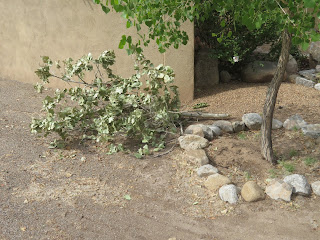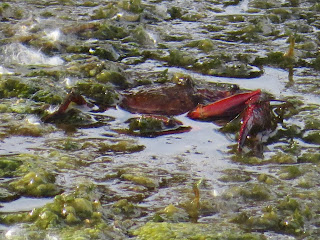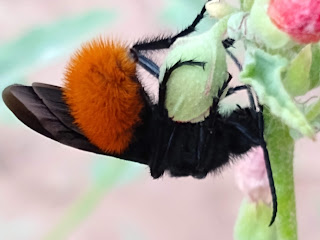The best part about nature watching is when you see the unusual or unexplained. Observing what is always there can get old, but things seen in a new light can bring a new perspective.

The rains are bringing growth to the plants, this cultivated hibiscus is a pretty fancy specimen. The amount of work that does into growing plant species of gardeners is astonishing.
During the rains, many moths seem shelter under the stucco roofs. It is odd to see them out during the day. Many birds like flycatchers are chasing after them right now.
This is a towhee, usually they are on the ground, but I guess they like to advertise too.
The doves are also calling, but then again. they do this all year, it seems
Other secretive birds come in for brief periods. This is definitely a great blue heron feather. Herons like to fish from the banks, especially during periods where the river level is high.
The plants are hard at work breaking down the building projects. Roots use hydrostatic pressure over time to enlarge cracks in concrete very effectively. The concrete is suseptible to contraction and expansion as the temperature changes so cheap concrete exposed to the atmosphere is not pristine for long.
This is the first time I have seen the grass growing in the clay on the bottom, usually the water flow is enough to flush the mud out into the clear ditch.
The warm sun has allowed algae and water weeds to begin colonizing new territory. The fine clay muds consolidate quickly when the water slows and resist being flushed. This surface allows plant colonization. Most fish prefer a sandy, clear water substrate.
The rains and sun allow many vareities of plants to thrive. Thee are many dense stands of nightshade right now, but a few surprises, like this...(tomatillo?) plant.
Light rains means migrations for animals. Here the new crop of toadlets are spreading out into the big world.
Darkling beetles are meeting and mating. They are often seen around the nests of harvester ants. I have never seen the beetles in tandem wonder if they are mating, or wrestling?
The velvet ants I see now have wings, so I assume they are male. The wings are stiff and leathery to resist ant bites I guess.
They seem to have very short life spans, The congregate in some areas, presumably near a female. They certainly act oddly for an ant species
The dragonflies in the plants are much smaller, but more than one species. This blue one looks like a damselfly in color.
A thread waisted wasp like this is usually some sort of caterpillar parasite. This one also seemed to be feeding on pollen.
There are actually many animals dead on the road right now. A tragic intersection of migration behaviors, dumb luck, and rubber. Many animals have switched to night living near humans to reduce these impacts. Toads, rabbits, and skunks make up the majority of these roadkills. Luckily the reproduce fast enough to compensate. The problem is highways like our I-25 and I-40 can also fragment and disrupt whole ecosystems. No animal that doesn't fly is going to be able to cross 6 lanes of freeway during any time of day. The drains that occasionally go under and might offer access are not exactly inviting for a wild animal, with the noise. Also, all access points are always watched over by predators such as coyote. Cars are such a huge problem for wildlife, and the whole planet.




























































